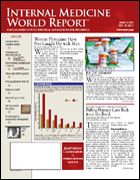Publication
Article
EXCITE: 2-Week Therapy Restores Arm Function in Stroke Patients
Author(s):
JAMA
Patients who had stroke and had lost function in 1 arm showed clinical improvement for up to 1 year after participating in a unique, 2-week rehabilitation regimen, reports the largest, most comprehensive study of its kind to date (. 2006; 296: 2095-2104).
The Extremity Constraint Induced Therapy Evaluation (EXCITE) study was conducted at 7 academic institutions between January 2001 and January 2003 and included 222 patients (mean age, 62 years) with predominantly ischemic stroke. All had weakness in 1 arm caused by a stroke within the previous 3 to 9 months.
The effects of constraint-induced movement therapy (CIMT)—which involves training the weak hand and arm through repetitive exercises while restraining the unaffected hand and arm with a mitt—in 106 patients was compared with customary care consisting of no treatment or standard physical therapy in 116 patients.
The treatment group was asked to wear the restraint every day and to participate in training sessions every weekday for several hours for a period of 2 weeks. Evaluations took place immediately after treatment and again at 4, 8, and 12 months later.
Compared with the customary-care group, those who received CIMT had improved function of the stroke-affected arm in timed tasks and in self-reported daily use at all time points. Among patients who were unable to perform certain tasks at all early in the study, those who received CIMT were more likely to regain the ability to perform those tasks at 12-month follow-up.
At 12 months, the CIMT group showed significantly greater improvements than the control group. A decrease of 19.5 points in self-perceived hand function difficulty was reported by the intervention group compared with 10.1 points by the control group.
“This study provides the strongest evidence to date that constraint-induced movement therapy can help stroke patients regain lost arm function,” said Elias A. Zerhouni, MD, director of the National Institutes of Health. “This is welcome news for stroke patients and those who care about them.”
In an editorial published in the same issue (pages 2141-2143), Andreas R. Luft, MD, and Daniel F. Hanley, MD, point out that even though this study contributes to our understanding of how to approach disability in stroke survivors, it also leaves several important questions unanswered, including:
• What is the optimal time point for this intervention?
• What is the long-term durability of the response?
• Does the location of the stroke predict efficacy?
“Despite the number of unanswered questions, constraint-induced therapy, if it were a drug, would probably receive approval based on the EXCITE results,” the editorialists conclude.
Until more evidence is available, physicians “must accept that time after stroke does not appear to be a limiting factor for recovery,” they stress. “There is still no clear idea as to the maximal amount of benefit that can be achieved with interventions that harness the learning powers of the human brain.”






